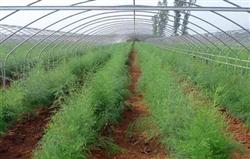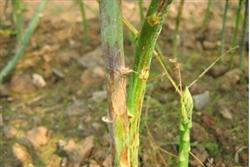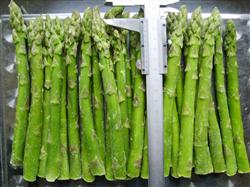How can asparagus be managed to produce high yield?

How can asparagus be managed to produce high yield? Please guide asparagus cultivation to high yield can refer to the following methods of management: first, to cultivate strong seedlings to obtain high yield of asparagus, in addition to selecting good varieties, it is also necessary to establish a nursery for seedling raising. The most suitable nursery period is June, and the seedling raising time is about 3 months. The row spacing of the plant is 16.5 cm × 16.5 cm. The medium seedling with 10-20 roots is the most suitable for transplanting seedlings. Second, asparagus like to grow in wet sandy loam. Before transplanting, it is necessary to plough the soil many times and remove impurities in the soil. After full exposure (about 1-2 months), 4000-150kg of rotten farm manure or 100kg-150kg cake fertilizer is applied per mu. Add 150kg calcium superphosphate and 30kg potassium chloride. After the manure was sprinkled and ploughed, the cake fertilizer should be ripened with water for 8-10 days and then mixed with calcium superphosphate and potassium chloride, and applied to the ditch with a depth of 30-40 cm to cover the soil before planting seedlings. Third, the most suitable seedling stage of reasonable close planting is from August to September in autumn, and the bamboo shoots are collected from March to April in the following year, with short time and high survival rate. The row spacing of planting seedlings is 25 cm × 160 cm. When planting, the root is divided into two halves, fixed in the planting ditch hole, the scale bud faces the middle line of the border, then covers the soil 5-6 cm, compacts and drips the root water. Fourth, strengthen fertilizer and water management 1. Seedling stage: if furrow irrigation is used after planting seedlings, irrigation can be done every 20-25 days. At the same time, drainage ditches should be opened so that the ground is dry when the rain stops. The first fertilizer was applied 20 days after planting, and 5 kg compound fertilizer was applied in 1000 kg water hole or ditch application per mu. 40-60 days after planting, fertilizing every 25-30 days, applying 25-50 kg compound fertilizer or 10-20 kg urea plus 6-12.5 kg potassium chloride per mu. From 4 months after planting to before bamboo shoot picking, fertilizer should be applied every 25 days or so, with 20 kg urea and 12.5 kg potassium chloride per mu. Water should be irrigated after fertilization. 2. Harvest time: fertilizing every 15-20 days during harvest, applying 20 kg of urea and 12.5 kg of potassium chloride per mu. At the same time, attention should be paid to the opening of four-sided ditches and Tanaka ditches, draining water in rainy days and irrigation in sunny days. 5. About 5-6 months after the fixed mother stem is planted, the seedlings give birth to the last batch of stem plants, and the mother stem can be selected when the stem diameter reaches 0.8-1 cm. Generally, 2-3 sturdy mother stems that are old and free of diseases and insect pests are left in each stem, and then the redundant, small or too thick stems are pulled out. Before setting the mother stem, 30 kg of urea and 15 kg of potassium chloride were applied per mu. After selecting the mother stem, we should immediately complete the bed and cultivate the soil into a box border with a height of 30-40 cm. The common diseases of asparagus include stem blight and anthrax. To control stem blight, 70% methyl thiophanate 600 times or 40% carbendazim 500 times can be sprayed once every 10-15 days in seedling and seedling stage, and every 5-7 days in mother stem selection period. Anthracnose can be controlled with 70% mancozeb 500 times, or 75% chlorothalonil wettable powder 600 times, or 80% anthrax Fumei wettable powder 800 times spray, once every 10 days, even 2-3 times, but spraying is strictly prohibited 7 days before bamboo shoots are picked. Common pests are land tigers and green insects. When the green worm is 1-2 instar, it can be sprayed with 1000 times solution of Anlubao, and the larvae of green worm and ground tiger can be killed artificially. 7. After 3-4 months of shoot harvesting, the original seedling begins to age. At this time, all the seedlings should be pulled out, leaving only the root shoots, and then ridging and fertilizing to attack the shoots. Generally, the seedlings should be changed twice a year. Harvesting white asparagus inspects the fields at dawn every day and finds cracks in the soil, that is, a sign that young stems are unearthed. First peel open the topsoil at the crack, determine the position of the young stem, insert a special bamboo shoots digging knife and cut it close to the underground stem so that the length of the young stem is more than 18 cm. Do not damage the underground stem when cutting. The hole after harvest should be filled with soil immediately. In the later stage of harvest, the weather is hotter and the young stem elongates quickly, so it must be collected once every morning and evening. The tender stems harvested should be immediately put into a container to prevent light coloring. The harvest duration and yield vary according to plant age, climate, soil quality, fertilization management and other specific conditions. Green asparagus began to harvest a small amount of tender stems in the second year after planting. Cut on the soil surface when the young stem is 21-24 cm high. Every time white asparagus or green asparagus is harvested, all the tender stems must be cut, otherwise the underground storage nutrients will be consumed and the yield will be affected. Generally, the peak production period is from 6 to 12 years after planting. After 13 years, the plant tends to senescence and the yield decreases gradually. The economic life of the plant is about 15 years. If the cultivation is well managed, it can be extended to about 20 years. Click to get more asparagus planting techniques click to get more vegetable planting techniques
- Prev

How to prevent and cure asparagus stem blight?
How to prevent and cure asparagus stem blight? Please introduce the methods of asparagus stem blight control can refer to the following methods: 1. Planting asparagus should choose sandy soil that is flat, fertile, irrigated and capable of drainage. 2. Timely and thorough treatment of the disabled body, overwintering straw must be disposed of before "the Spring Equinox"; diseased branches must be removed in time.
- Next

How can asparagus be planted with high yield?
How can asparagus be planted with high yield? Asparagus, also known as asparagus, high-grade nutrition and health vegetables, known as "king of vegetables" and "one of the top ten famous dishes in the world", can be processed into canned and nutritious products, and it is a "gold industry" for export to earn foreign exchange. The market is tight and the price is high. Asparagus is a perennial crop.
Related
- Where is it suitable to grow horseradish in China? it is expected to see the middle altitude horseradish in Alishan.
- How to prevent tomato virus disease reasonably? (Control methods included)
- Many people like to plant towel gourd on the balcony. What are the main points of this method and management?
- What crops can chili peppers be mixed with?
- Fertilization techniques and matters needing attention in Tomato
- What are the grafting techniques for peach seedlings in spring?
- Harm and control methods of root swelling disease of Chinese cabbage
- What are the pests of sweet potatoes? How to prevent and cure it?
- Symptoms, causes and Control methods of navel Rot in Tomato
- The cause of "Cucumber rotten bibcock" in Farmers' planting Cucumber and its Control Plan

